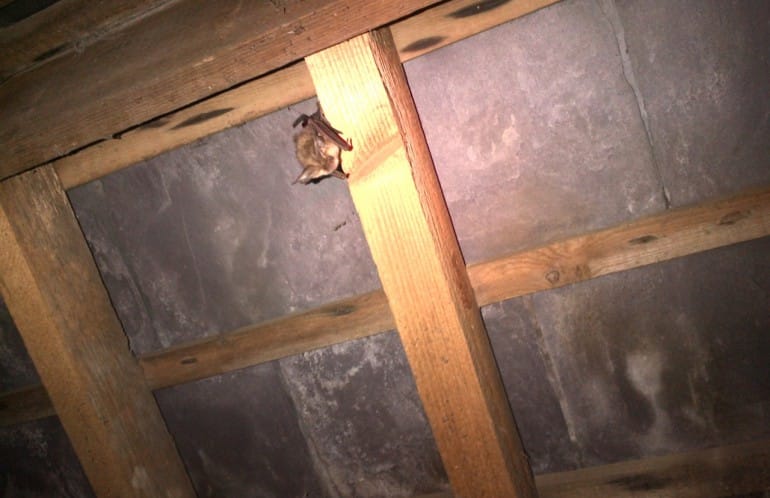
In the UK, insects are the primary food source for bats. Here, as elsewhere in temperate climates, all eighteen species of British bat hibernate throughout the winter when the insects on which they predate are less abundant. This hibernation period coincides with cold weather that insects cannot protect themselves from winter temperatures without extreme measures—as they have no body fat reserves. These measures limit not only exposure risk to the elements but in so doing, also protect the insects from predation.
The life cycle of British bats
Extreme measures include migration and life cycle timing i.e. some insects dies in the winter having laid eggs that will hatch the following spring. Many insects though, simply hibernate. Honey bees and ants—not favorites for bats but instead are simply a good example of insects most people are familiar with—hibernate by huddling close together to conserve body heat. Most worker bees die off but the queen (the breeding female) and some other individuals normally survive the winter. Ants by contrast head below ground, to avoid the harshest temperatures. Below the frost line, they can hibernate in an environment that is several degree warmer than the air temperature at ground level.
Small, crevice dwelling species of bats
Small species of bats such as common or soprano pipistrelles, (Pipistrellus pipistrellus) and (pygmaeus) respectively, and whiskered bats, (Myotis mystacinus) and related species, feed upon e.g. midges and gnats.
Larger species of bats
Brown long eared bats, (Plecotus auritus) and noctules, (Nyctalus noctula) feed on e.g. yellow under-wing moths and peacock butterflies. These sorts of insects hibernate underground in natural features such as caves and also in man-made features, like old Victorian ice-houses.
Winter bat roosting
In winter, with the insects gone, bats in temperate climates had three evolutionary choices available to them (recall they are mammals): find alternative food sources, migrate or hibernate. The bats chose to gorge themselves when insects are in number, put on sufficient fat reserves for the winter and hibernate. They do this by roosting in winter habitat features known as hibernacula—from the Latin “for winter housing.” In order to meet the physiological demands on the bats’ bodies during months of freezing temperature, little water, low humidity and no food—they can lose half their body weight over winter—bats end up having to build up considerable fat reserves during the summer months and in consequence are active daily in all but the most appalling weather conditions during this time. These fat reserves are critical to the survival of bat during the winter, as even in their state of torpor they burn calories, that is, they metabolise their body fat—a luxury insects don’t have. During summer, a bat’s heart can beat several hundred times in a single minute, as opposed to only a handful of times a minute during hibernation. This tremendous biological adaptation promotes a vulnerability to bats as much as it solves their problems. Though they wake naturally and on occasion during hibernation, to drink, (attempt to) mate and defecate, if woken suddenly during hibernation they can be killed outright, or the increase in metabolism can deplete their valuable fat reserves and they literally starve.
Take home points for planning applicants
a) As ODPM Circular 06/05 and NPPF require local authorities to offer protected species “material consideration” in a planning application where there is a reasonable likelihood they will be “present and affected,” so you must undertake surveys outside of the hibernation season before submitting your application. b) As the Habitats Regulations 2010 prohibit killing, injury and disturbance, so you must avoid the hibernation season if you are undertaking works to a hibernation roost, during the hibernation season.
So when can I survey for bats?
Surveys for bat habitat and evidence e.g. droppings, urine staining, dead bat carcasses, bit of prey—such as moth wings—can be undertaken year round. Surveys for dusk emergence and dawn swarming activity are limited in reality to weather conditions conducive to insect proliferation. In practice, however, there are some general rules of thumb. April until October is OK if weather conditions are mild, though the very beginning and end of this range is still considered sub-optimal so your survey effort may need to be greater to provide scientific validity. In practice, most local planning authorities will accept mitigation proposals that are designed having been based upon bat surveys that meet the following conditions:
- Must be undertaken in the period 01 May to 30 September (in exceptional circumstances, April to October)
- Must be mild and fair weather conditions
- Must have a low point temperature of at least seven degrees Celsius during the survey effort
You can find out more specifically about bat mitigation and licencing here.

There are no comments yet. Why not get involved?